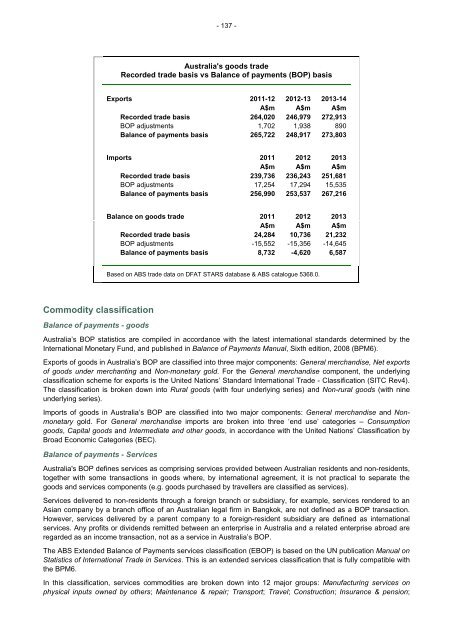cot-fy-2013-14
cot-fy-2013-14
cot-fy-2013-14
Create successful ePaper yourself
Turn your PDF publications into a flip-book with our unique Google optimized e-Paper software.
- 137 -<br />
Australia's goods trade<br />
Recorded trade basis vs Balance of payments (BOP) basis<br />
Exports 2011-12 2012-13 <strong>2013</strong>-<strong>14</strong><br />
A$m A$m A$m<br />
Recorded trade basis 264,020 246,979 272,913<br />
BOP adjustments 1,702 1,938 890<br />
Balance of payments basis 265,722 248,917 273,803<br />
Imports 2011 2012 <strong>2013</strong><br />
A$m A$m A$m<br />
Recorded trade basis 239,736 236,243 251,681<br />
BOP adjustments 17,254 17,294 15,535<br />
Balance of payments basis 256,990 253,537 267,216<br />
Balance on goods trade 2011 2012 <strong>2013</strong><br />
A$m A$m A$m<br />
Recorded trade basis 24,284 10,736 21,232<br />
BOP adjustments -15,552 -15,356 -<strong>14</strong>,645<br />
Balance of payments basis 8,732 -4,620 6,587<br />
Based on ABS trade data on DFAT STARS database & ABS catalogue 5368.0.<br />
Commodity classification<br />
Balance of payments - goods<br />
Australia’s BOP statistics are compiled in accordance with the latest international standards determined by the<br />
International Monetary Fund, and published in Balance of Payments Manual, Sixth edition, 2008 (BPM6).<br />
Exports of goods in Australia’s BOP are classified into three major components: General merchandise, Net exports<br />
of goods under merchanting and Non-monetary gold. For the General merchandise component, the underlying<br />
classification scheme for exports is the United Nations’ Standard International Trade - Classification (SITC Rev4).<br />
The classification is broken down into Rural goods (with four underlying series) and Non-rural goods (with nine<br />
underlying series).<br />
Imports of goods in Australia’s BOP are classified into two major components: General merchandise and Nonmonetary<br />
gold. For General merchandise imports are broken into three ‘end use’ categories – Consumption<br />
goods, Capital goods and Intermediate and other goods, in accordance with the United Nations’ Classification by<br />
Broad Economic Categories (BEC).<br />
Balance of payments - Services<br />
Australia's BOP defines services as comprising services provided between Australian residents and non-residents,<br />
together with some transactions in goods where, by international agreement, it is not practical to separate the<br />
goods and services components (e.g. goods purchased by travellers are classified as services).<br />
Services delivered to non-residents through a foreign branch or subsidiary, for example, services rendered to an<br />
Asian company by a branch office of an Australian legal firm in Bangkok, are not defined as a BOP transaction.<br />
However, services delivered by a parent company to a foreign-resident subsidiary are defined as international<br />
services. Any profits or dividends remitted between an enterprise in Australia and a related enterprise abroad are<br />
regarded as an income transaction, not as a service in Australia’s BOP.<br />
The ABS Extended Balance of Payments services classification (EBOP) is based on the UN publication Manual on<br />
Statistics of International Trade in Services. This is an extended services classification that is fully compatible with<br />
the BPM6.<br />
In this classification, services commodities are broken down into 12 major groups: Manufacturing services on<br />
physical inputs owned by others; Maintenance & repair; Transport; Travel; Construction; Insurance & pension;


